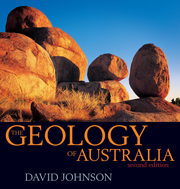Book contents
- Frontmatter
- Contents
- Map
- Preface
- Acknowledgements
- Map of main localities mentioned
- Abbreviations and units
- 1 An Australian perspective
- 2 The Earth: A geology primer
- 3 Building the core of Precambrian rocks
- 4 Warm times: Tropical corals and arid lands
- 5 Icehouse: Carboniferous and Permian glaciation
- 6 Mesozoic warming: The great inland plains and seas
- 7 Birth of modern Australia: Flowering plants, mammals and deserts
- 8 The history and evolution of life on Earth
- 9 Eastern highlands and volcanoes barely extinct
- 10 Building the continental shelf and coastlines
- 11 Great Barrier Reef
- 12 Planets, moons, meteorites and impact craters
- 13 A geological perspective on climate change
- 14 Cycles in a continental journey
- Sources and references
- Figure sources
- Index
9 - Eastern highlands and volcanoes barely extinct
Published online by Cambridge University Press: 05 August 2013
- Frontmatter
- Contents
- Map
- Preface
- Acknowledgements
- Map of main localities mentioned
- Abbreviations and units
- 1 An Australian perspective
- 2 The Earth: A geology primer
- 3 Building the core of Precambrian rocks
- 4 Warm times: Tropical corals and arid lands
- 5 Icehouse: Carboniferous and Permian glaciation
- 6 Mesozoic warming: The great inland plains and seas
- 7 Birth of modern Australia: Flowering plants, mammals and deserts
- 8 The history and evolution of life on Earth
- 9 Eastern highlands and volcanoes barely extinct
- 10 Building the continental shelf and coastlines
- 11 Great Barrier Reef
- 12 Planets, moons, meteorites and impact craters
- 13 A geological perspective on climate change
- 14 Cycles in a continental journey
- Sources and references
- Figure sources
- Index
Summary
Australia is the only continent in the world without active volcanoes – but that was not so in the past. There has been regular volcanism throughout Australia's geological history, especially andesitic and rhyolitic volcanism along the eastern margin. The most recent basaltic phase has barely finished. Basalt eruptions started around 70 Ma ago and lasted until the most recent eruptions in South Australia 4600 years ago. There is a close relationship between these basalts and the Great Divide: why?
Rich soils derived from the weathered basalt on elevated country, combined with a cooler and wetter climate form the basis for many of our finest agricultural and horticultural areas.
VOLCANIC PROVINCES
The Australian mainland has no active volcanoes, though there are two active volcanoes in the offshore territory of Heard and McDonald Islands. These two islands are part of the Kerguelen volcanic system and lie about 4000 km southwest of Australia, and some 1500 km north of Antarctica. The volcano, Big Ben, on Heard Island has a high point (Mawson Peak) at 2745m ASL, with a thick mantle of snow and glacial ice, and last erupted in 1992. The McDonald Island volcano is only 230m high, and erupted in 2001 and 2005.
Most of the volcanism in Australia has been of andesites and rhyolites, rocks formed mainly during compressive tectonics when there is considerable melting of continental crust.
- Type
- Chapter
- Information
- The Geology of Australia , pp. 189 - 206Publisher: Cambridge University PressPrint publication year: 2009



